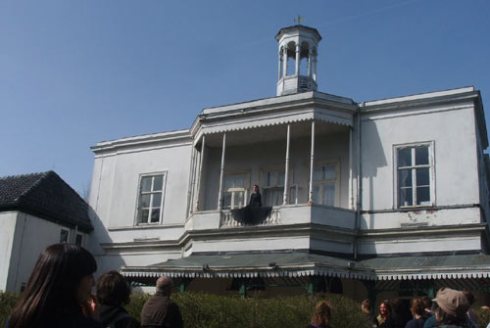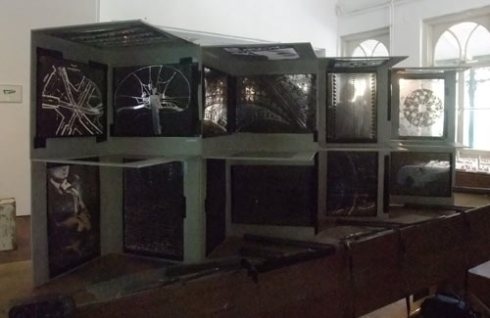“Kāinga a roto | Kāinga a waho”
(Home within | Home on the outside)
gallery space + botanic garden proposal
Sonja van Kerkhoff + Sen McGlinn, The Netherlands
See the changed project to suit the possibilities in Puke Ariki, August 2012 or the final one in Oct 2012
1. Project description
To research Māori building and construction techniques, using the archives of Puke Ariki as well as via interviews with tangata whenua and visits to existing buildings and sites in Taranaki. Then with the material collected, we intend to build two structures, one intended to house a 5 screen video installation to be located inside (possibly Puke Ariki) and another that will function as a sculptural-shelter in Pukekura Park. We will combine what we learn from our research with other building techniques to create a hybrid work that straddles various worlds. Ecologically sound materials will be used either utilizing recycled materials, straw bales (perhaps the strawbale + clay building technique, a skill we have), or bales made from weeds or perhaps woven or bound flax. An aim in the choice of materials for the interior work will be to bring the outside (rural Taranaki) in and for the outdoor work we will be looking at reflecting something of the ‘inner’ world/s or make a play on inside/outside through a construction that functions as a sculptural intervention. If feasible, we will incorporate a natural process for the work to return to nature in the form of a compost-able work of art. Our goal while working on both projects would be to network and coordinate with others, either teaching skills as they help us or to make use of the knowledge or skills of others in the manner of workshops where the public can participate.
2. An image.
 Click on this to view it full size.
Click on this to view it full size.
3. Relevance
We will be taking a scientific approach in the manner that we will research for information in Puke Ariki and other archives and in the sense of how we translate what we have learnt into the two structures we will build. We will use recycled materials or materials that later can be re-used or decompose back into nature. However our main aim will an artistic statement. Each construction will be in response to the theme “Home Within – Home on the Outside”. The construction intended for an interior space will house an existing 5 screen video and sound art work which features locations in Taranaki where Sonja was born. Most imagery is close-up and is intended to give viewers a sense of being ‘in’ nature or at least in close approximately to nature’s ‘skin.’
Our aim for these constructions will be to see what we can discover about Māori construction techniques which will involve acknowledging the associated world views as much as any physical aspect, that could contribute to artworks addressing themes of translocation rather than to imitate any particular building form. It would also be our aim to do some outreach into the farming community in general as well, hence a starting point will be do see how we can incorporate hay or straw bales as a sustainable building material in relation to Māori architectural traditions.
4. Possible outputs:
A video/sound and sculptural installation as part of an exhibition. Workshops could be given inside this space.
Workshops to be given during the research part of the project where we could set up a studio space in Puke Ariki and the public can also engage with us while we are there. If we use Puke Ariki as a workspace we would give workshops at particular times so the public can participate in these. Likewise if we work at WITT then we could give workshops there for students or for the public. These workshops would be art oriented with a practical aspect. Sonja could also present a paper on the results of the research into Māori construction methodologies in relation to practices of sustainability and conceptual art. The construction in Pukekura park could house another work or exist in any location. It could be small (intimate) or like a shelter or room. We could do a pecha kucha presentation of the final project.
5a. Bio
Sen McGlinn and Sonja van Kerkhoff, both born and raised in Aotearoa (New Zealand) have been based in the Netherlands since 1989 and have been making art works independently, together, or in collaboration with others since the mid 1980s. Most of their work, often in the form of a site specific installation, relates to the human condition as an interweaving of the spiritual, social and material. For example in 2009 they participated in the “Treetop Gallery” in Regents Park in London, U.K., where Sen delivered a lecture in a tree house on “Structuring Society in an age of globalisation” while Sonja’s contribution was the hanging of orange tinted translucent tulips.
5b. c.v.
Sen McGlinn, born 1956, Christchurch, Aotearoa / New Zealand.
Sonja van Kerkhoff, born 1960, Hawera, Taranaki, Aotearoa / New Zealand.
They live in Leiden, The Netherlands.
2012 “Into the line of Time” site specific installation, SPLORE arts festival, Tapapakanga Regional Park, Aotearoa/New Zealand.
2011 Performance, Yuchengco Museum, Manila, The Philippines.
2011 Installation, Le Blanc Gallery, Manila, The Philippines.
2011 Installation, ISEA Istanbul, Turkey.
2011 Print, Municipal Museum of Gwangju, South Korea.
2011 Co-curation, EAE Gallery, Leiden, The Netherlands.
2011 Installation, Parlour Project Space, Queens Cresent, London, U.K.
2010 Installation, Museum Beelden aan Zee (Museum of Sculpture), Scheveningen, The Netherlands.
There is a fuller c.v. here (sonjavank.com/cv.htm)
Tags: Aotearoa, artScience, installation


 Installation by Marijke van Gorp, Ludmila Rodrigues, Mike Rijnierse and Nenad Popov at Villa Ockenburgh, Loosduinen, The Hague, April 10th, 2011.
Installation by Marijke van Gorp, Ludmila Rodrigues, Mike Rijnierse and Nenad Popov at Villa Ockenburgh, Loosduinen, The Hague, April 10th, 2011.
 Click on this to view it full size.
Click on this to view it full size.